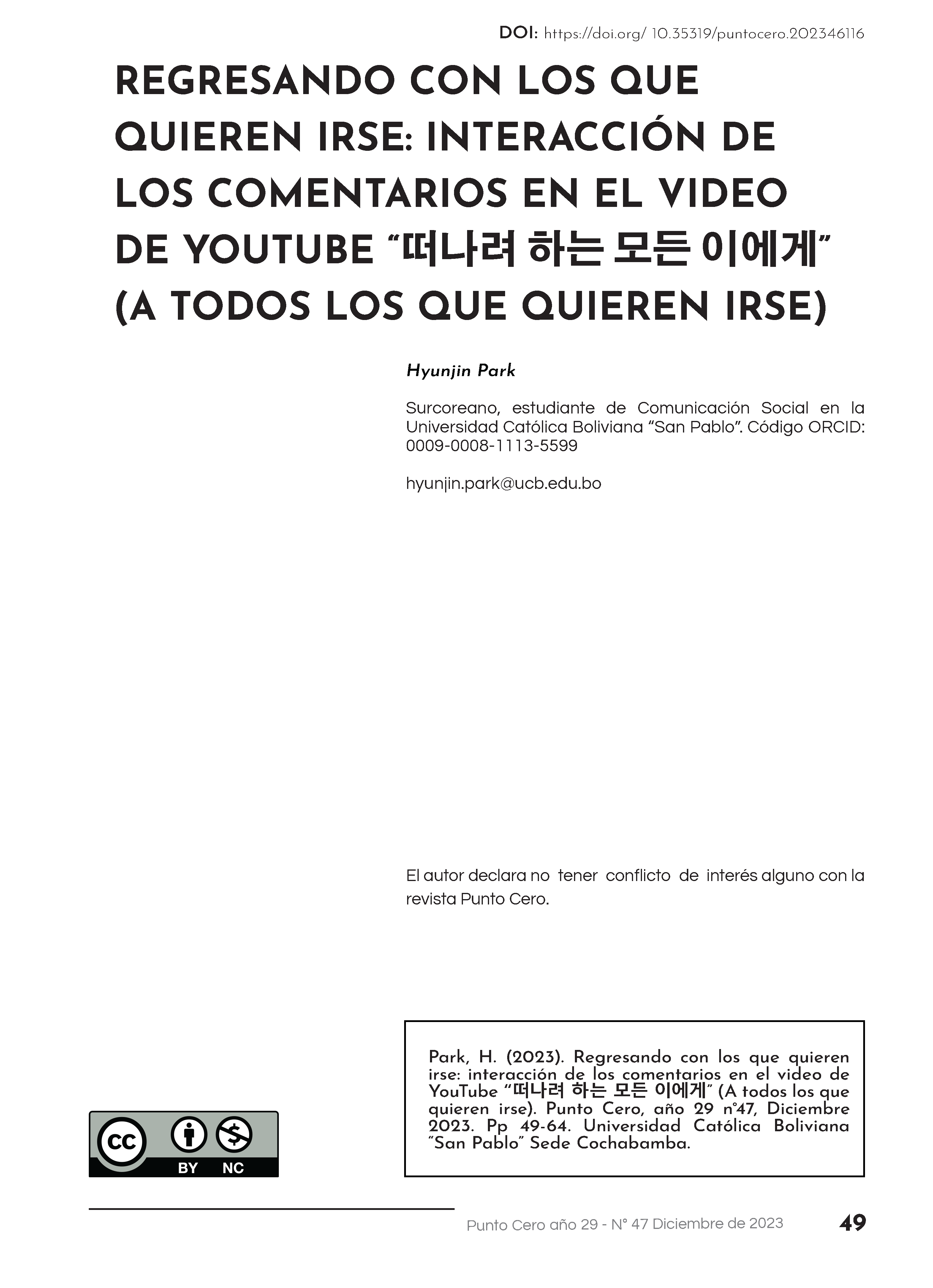Returning to those who want to leave: comment interaction on the YouTube video “떠나려 하는 모든 이에게” (to all those who want to leave)
DOI:
https://doi.org/10.35319/puntocero.202347211Keywords:
Social interaction, YouTube, Mental health, South KoreaAbstract
The present investigation aims to analyze the interaction of the comments in the video “떠나려 하는 모든 이에게” (To all whom wants to leave) of the channel “새던” (Sedawnn) in YouTube in April of 2021. This video was a case of success of a virtual community formed for purpose of consolation in the middle of high indexes of suicide and social isolation in South Korea. With a deliberate sample of 253 comments, a quantitative methodology using the three variants of content analysis was applied to achieve the results: thematic, semantic and network. The interaction in this space is expressive and positive in its attitude, interpersonal and informal in its speech, and complementary and functional in its mode of relation. This opens up the discussion of platform of YouTube as a potential space of consolation as well as the digital social media's contribution in communication for mental health.
References
Alemán-Andrade, A., & Jiménez, C. (2021). Guía de consideraciones éticas de investigación social y de Comunicación. Universidad Católica Boliviana “San Pablo” Unidad Académica Regional Cochabamba.
Arroyo Menéndez, M. (2012). Metodología de la investigación social: Técnicas innovadoras y sus aplicaciones. Editorial Síntesis.
Bajoit, G. (2013). Hacia una teoría socio-analítica de la relación social. Universitas, 18, 17-52. DOI: https://doi.org/10.17163/uni.n18.2013.01
Barthes, R. (1971). Elementos de Semiología. Alberto Corazón.
Beltrán, L. R. (2010). Comunicación para la salud del pueblo. Una revisión de conceptos básicos. Estudios sobre las culturas contemporáneas, 16(31), 16-65.
Bryman, A. (2012). Social Research Methods. Oxford University Press.
De Saussure, F. (1945). Curso de lingüística general. Losada.
Garcés-Prettel, M., Barredo-Ibáñez, D., Arroyave-Cabrera, J., & Santoya-Montes, Y. (2023). Suicide risk and media consumption in the COVID-19 pandemic in Colombia. Revista de Comunicación, 22(1), 153-164. https://doi.org/10.26441/RC22.1-2023-2975 DOI: https://doi.org/10.26441/RC22.1-2023-2975
García-Marín, J., & Serrano-Contreras, I.-J. (2023). (Un)founded fear towards the algorithm: YouTube recommendations and polarisation. Comunicar, 31(74), 61-70. https://doi.org/10.3916/C74-2023-05 DOI: https://doi.org/10.3916/C74-2023-05
Guardia Crespo, M. (2003). Interacciones: La dimensión comunicacional de la cultura. UPSA.
Hernández Sampieri, R. (2014). Metodología de la investigación—6ta edición (6.a ed.). Interamerciana Editories.
Jeong, J.-H. (2022, enero 11). One-third of Koreans feel socially isolated: Statistics Korea. Korea JoongAng Daily. https://koreajoongangdaily.joins.com/2022/01/11/national/socialAffairs/social-isolation-lonely/20220111172613912.html
Jobst, N. (2023, junio 9). South Korea: YouTube usage rate by age 2022. Statista. https://www.statista.com/statistics/1389205/south-korea-youtube-usage-rate-south-korea-by-age-group/
López, P. L. (2004). Población muestra y muestreo. Punto Cero, 9(8), 69-74.
Lozano-Blasco, R., Mira-Aladrén, M., & Gil-Lamata, M. (2023). Social media influence on young people and children: Analysis on Instagram, Twitter and YouTube. Comunicar, 31(74), 125- 137. https://doi.org/10.3916/C74-2023-10 DOI: https://doi.org/10.3916/C74-2023-10
Lozares Colina, C. (2005). Bases socio-metodológicas para el Análisis de Redes Sociales, ARS. Empiria. Revista de metodología de ciencias sociales, 0(10), 9-35. https://doi.org/10.5944/empiria.10.2005.1042 DOI: https://doi.org/10.5944/empiria.10.2005.1042
Luengo, O., García-Marín, J., & de-Blasio, E. (2021). COVID-19 on YouTube: Debates and polarisation in the digital sphere. Comunicar, 29(69), 9-19. https://doi.org/10.3916/C69-2021-01 DOI: https://doi.org/10.3916/C69-2021-01
Madden, A., Ruthven, I., & McMenemy, D. (2013). A classification scheme for content analyses of YouTube video comments. Journal of Documentation, 69(5), 693-714. DOI: https://doi.org/10.1108/JD-06-2012-0078
OECD. (2023). Suicide rates. https://data.oecd.org/healthstat/suicide-rates.htm
Park, S.-W. (2021, diciembre 8). 전체 인구 중 32%가 1人 가구…서울·경기 등 수도권에 40% 몰려있어. ChosunBiz. https://biz.chosun.com/policy/policy_sub/2021/12/08/2X3QKSC7OVGBFPKAZIMCD7C72I/
Pérez-Torres, V., Pastor-Ruiz, Y., & Abarrou-Ben-Boubaker, S. (2018). YouTuber videos and the construction of adolescent identity. Comunicar, 26(55), 61-70. https://doi.org/10.3916/C55-2018-06 DOI: https://doi.org/10.3916/C55-2018-06
Pokharel, R., & Bhatta, D. (2021). Classifying YouTube Comments Based on Sentiment and Type of Sentence (arXiv:2111.01908). arXiv. http://arxiv.org/abs/2111.01908
Ralph, F. (1984). The sociolinguistics of society. Basil Blackwell.
Rodrigues Costa, P., & Capoano, E. (2020). O medo do consumo solitário: Comentários em canais infantojuvenis de YouTube do Brasil e de Portugal. Journal of Iberian and Latin American Research, 26(3), 407-426. https://doi.org/10.1080/13260219.2020.1909872 DOI: https://doi.org/10.1080/13260219.2020.1909872
Sedawnn. (2021, abril 4). 떠나려 하는 모든 이에게. https://www.youtube.com/watch?v=iJyac4AXKKY
Song, J. J. (2005). The Korean language: Structure, use and context. Routledge. DOI: https://doi.org/10.4324/9780203390825
Suárez, H. J., Bajoit, G., & Zubillaga, V. (2013). La Sociedad de la Incertidumbre. Universidad Nacional Autónoma de México.
Thelwall, M., Sud, P., & Vis, F. (2012). Commenting on YouTube videos: From guatemalan rock to El Big Bang. Journal of the American Society for Information Science and Technology, 63(3), 616-629. https://doi.org/10.1002/asi.21679 DOI: https://doi.org/10.1002/asi.21679
Watzlawick, P. (2014). No es posible no comunicar. Herder. DOI: https://doi.org/10.2307/j.ctvt9k2zc
Watzlawick, P., Beavin, J., & Jackson, D. (1985). Teoría de la comunicación humana: Interacciones, patologías y paradojas (4.a ed.). Herder.
Zapata Arriarán, M. R. (2021). Sufrimientos humanos con, en y a través de la conectividad digital. DOI: https://doi.org/10.35319/puntocero.202143180

Downloads
Published
How to Cite
Issue
Section
License
Copyright (c) 2023 Revista Punto Cero

This work is licensed under a Creative Commons Attribution-NonCommercial 4.0 International License.








